Warbler Pileup
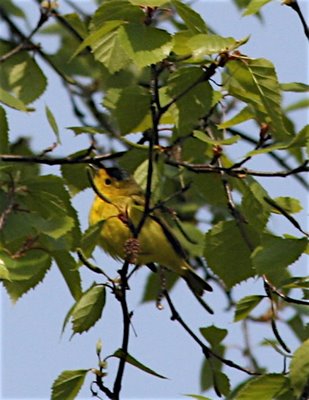
After giving a Friday night keynote at the Chequemegon Bay Birding and Nature Festival, I had a field trip Saturday morning, and then a free afternoon. Thank you, Ryan Brady, for inviting me, for letting me do my thing and experience the beauty of lakeshore Wisconsin. I owe you several! The keynote went really well; the field trip was fabulous. There's almost nothing trip leaders Matt and Betsy don't know about boreal wildlife and flora, from fungi right on up to bears. We noticed that there were waves of warblers going along the Sea Caves trail just west of Bayfield, and none of them seemed to want to fly out over the lake. Who could blame them? It was 32 degrees and snowing! This got my wheels turning about where to go Sunday afternoon. Using geography and bad weather to my advantage, I headed out to the two most prominent peninsulae on Wisconsin's north shore. I figured that migrants would not want to cross Superior with a headwind (it was coming out of the east, very strongly, whipping up whitecaps) and with the double handicap of severe cold and scarce food. They'd want to camp awhile, wait out the headwind, and fly when they'd had a chance to refuel and warm up a bit. And most importantly, I knew they would be stacking up on the north-pointing peninsulae, just as they stack up at Crane Creek on Ohio's north shore, and on Point Pelee after crossing Lake Erie. On Sunday, the temperature never got above 42, but it felt like a gift after Saturday, which stayed in the low 30's. Brrrr! I was swaddled in five layers, one of which was prime goosedown, and my best winter hat. I hadn't packed gloves (it just seemed like overkill for late May!), and by midday Saturday I was walking with my hands down my pants--first the front side, then the back--trying to thaw them. Note to self: Buns don't warm hands as well as belly does. Too well-insulated. Every time I lifted my binoculars it was like holding a big ice cube, and it would take my painstakingly warmed hands back to freezing again.
Roman's Point was just the ticket. Densely wooded in spruce, birch, sugar maple and balsam fir, it provided safe haven and caterpillars for more warblers than I've ever seen in one place at one time. When waves appeared, they'd swarm through the trees at all levels. Everywhere I looked was a bird, sometimes several. It was stunning, and I was completely alone to enjoy it. Maybe nobody else thought to go out the peninsulae, amazing as that seemed. It certainly would have been a good time to lead a field trip!
I rolled slowly along in my little rented Impala, snapping pictures out the window. When a good wave came along, I'd decar, and walk silently on the dirt road, moving as little as possible.
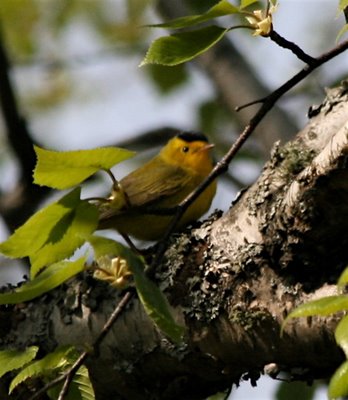
Wilson's warbler is quite common in the West, but a bit of a prize back East. We get them every few years on our farm, always in spring. The Wilson's male wears a yarmulke of black, and sings a staccato song that's somewhere in between a Nashville's and a magnolia's. It's one of the ones I have to chase down each time I hear it.
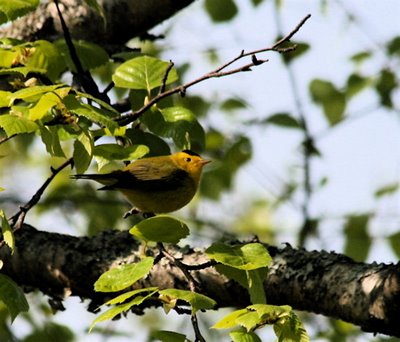
Finally-a Blackburnian low enough in a tree that I could get something recognizable.
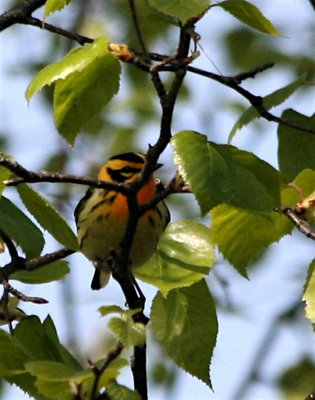 As cold as it was-42 degrees-these birds were pulling caterpillars out from under leaves with good frequency, and I felt happy to see them fill their stomachs with good food. I would hate to be a caterpillar on Roman's point, in an east wind at 42 degrees.
As cold as it was-42 degrees-these birds were pulling caterpillars out from under leaves with good frequency, and I felt happy to see them fill their stomachs with good food. I would hate to be a caterpillar on Roman's point, in an east wind at 42 degrees. 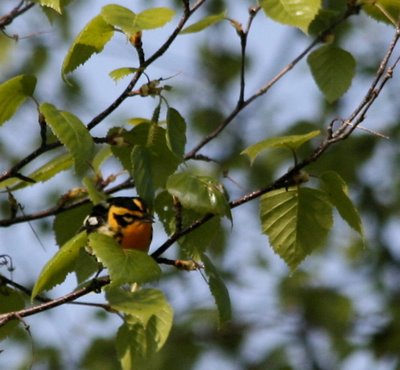 There was a corps of gleaners looking to lay on fat, and they were gong to stay on the point until the wind shifted.
There was a corps of gleaners looking to lay on fat, and they were gong to stay on the point until the wind shifted.He stretched to grab a luckless caterpillar, giving me a pure shot of flame.
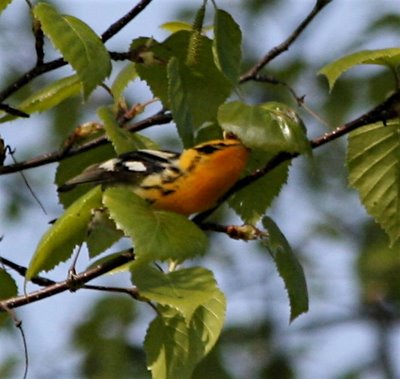
This little female magnolia warbler gave me pause for a moment; I'm always thinking about Kirtland's warblers and hoping for lightning to strike. But she was cute and she didn't have to be federally endangered to captivate me.
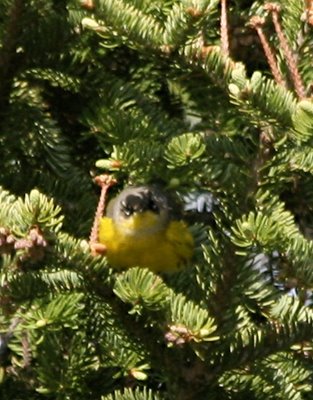 Black-throated green warblers were singing their distinctive whistling buzz--zee zee zee zu zee! everywhere I went.
Black-throated green warblers were singing their distinctive whistling buzz--zee zee zee zu zee! everywhere I went. Black-bearded warbler would be a good name. It's rare to get one down low like this. Just another benefit of birding in rotten weather.
Black-bearded warbler would be a good name. It's rare to get one down low like this. Just another benefit of birding in rotten weather. 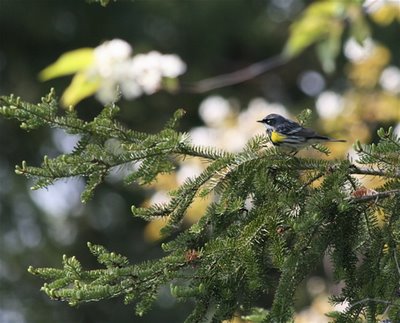
Asked why he never painted warblers, the great landscape and wildlife painter Francis Lee Jacques said, "The difference between warblers and no warblers in a landscape is very slight." As much as I love Jacques' work (he most famously painted the backdrops for the American Museum of Natural History's dioramas), I beg to differ.. To me, this spruce tree finds its spirit in the yellow-rumped warbler. His jingling song sifts through the spruce needles, hangs on the boughs like tinsel.
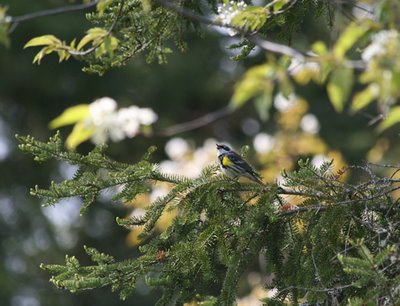
Wisconsin for spring warbler migration. Put it on your calendar for next year. Chequamegon Bay Birding and Nature Festival. Terrific people, ambitious field trips, migrants dripping off the trees. You might need to pack a parka and hat. And gloves. But remember: There's no such thing as bad weather, only bad gear. Oh, and you pronounce it Sha-WAH-mah-gun. It only took me three days to get it right. Definitely beats stuttering, "Check-kwa-MEE-gone" and having the locals look at you with real pity. Do yourself a favor. Pencil it in on your calendar right NOW.
Labels: Blackburnian warbler, spring migration, Warblers, Wilson's warbler, yellow-rumped warbler





